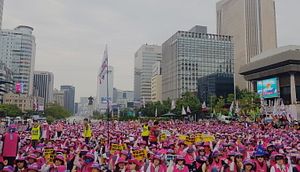Walking the streets of Seoul on any given day, it is impossible to avoid scenes of protest. In particular Gwanghwamun Square in the central Jongno district has become an area of focus for protesters, with semi-permanent tents erected for long-term protests, and usually with counterprotests located on the opposite side of the road. Mass protests, like those currently taking place over Japanese trade restrictions, or those that led to the impeachment of President Park Geun-hye in late 2016, form easily and are able to comprise of a wide cross-section of South Korean society.
This ubiquity of demonstrations on Seoul’s streets highlights a unique facet of South Korea’s political culture, and provides an essential component for understanding the relationship between the Korean public and the state. During South Korea’s long period of authoritarian rule (1948-87) protests were seen as the only channel citizens had to express their grievances to the state. However, since the country’s reformation as a liberal-democratic society — with theoretically a greater ability for interest groups to engage with the state — extra-institutional collective action has continued as the primary avenue for the public to convey their interests and concerns.
That’s partly because, in a hangover from the country’s authoritarian period, there is a lack of systematic interaction between the state and the public. While democratization has provided citizens with the ability to vote, there remains an absence of adequate mediating institutions within the country, preventing the inclusion of civil society in the policymaking process. Protest therefore provides a form of quasi-empowerment, giving people a sense of power yet without sophisticated participation in the activities of the state. Although protest is remarkably useful in putting certain issues on the table — and even in removing presidents — it falls short of giving civil society the ability to plan, draft, implement, and monitor policies in conjunction with the government.
In other liberal-democratic societies a strong web of coordinated interest groups serves this function. Groups that have independent budgets and distinct organizational capacities are able to engage in sustained and close relations with governments. However, in South Korea this process is less refined. When interest groups are invited to provide input into policymaking through hearings or debates in the National Assembly, the assembly’s internal incohesive nature and disagreements among parliament members are so intense that they tend to overwhelm the voices of the invited groups. One notorious case is the Four Rivers Restoration Project in 2009 where such disagreements lasted for more than three years, prompting the country’s court system to take over the issue.
The weakness of these institutional frameworks is reflected in the ever-shifting nature of party politics in South Korea. Frequent party splits, mergers, and name changes are a defining feature of the country’s democracy, with the longevity of political parties being less than five years. This continued instability of party organizations ferments suspicion, apathy, and distrust within the public, while simultaneously rendering the parties ineffective at forming, articulating, and representing solid platforms that can reflect the public’s interests.
This weak institutionalism is further compounded by a distinct sense of regionalism in Korean society. Presidential candidates can receive overwhelming support in one area of the country, while obtaining only limited support in another as political parties exhibit weak ideological ties and instead display stronger regional ties. Honam (the southwest region) and Yeongnam (the southeast) are the liberal and conservative home bases, respectively. Although the liberal Moon Jae-in may be seen as an exception as he managed to win in the Yeongnam city of Busan, this can be explained by the fact that he is from the city. The tendency to vote for candidates coming from the same region further incentivizes political parties to focus on regional identities rather than concrete issues, encouraging more protest.
This culture of protest also has a uniquely Korean social-psychological dimension known as “han.” The concept of han in Korean society can be described as a deep sense of sorrow and anger that is felt as a response to conditions of injustice and suffering, and speaks to a sense of helplessness deriving from a perceived lack of security and power. Korea’s historical context is useful for understanding this phenomenon. The peninsula has been invaded countless times in its history and long been overshadowed by Chinese influence. The brutal Japanese occupation (1910-45) and the externally imposed division of the peninsula weigh heavily as the most recent traumatic events. The result of which is the “culturally specific, ultra-distilled form of rage” that Koreans call han.
This intrinsic element of Korean society is essential for understanding why South Korea’s democracy exhibits the features that it does. Attempting to engage with Korean politics and society through a Western Platonic tradition — which seeks to separate emotion from rationality by undermining the former — will fail to fully grasp the country’s political complexity, and not respect Korean society on its own terms. Appreciating the centrality of han to conflict resolution is essential for understanding why protests form such an integral part of South Korean society, and why — the country’s institutional weaknesses aside — sustained protest should not be considered a sign of political dysfunction.
While improvements to existing participatory mechanisms and institutionalization of parties would be welcome enhancements to South Korea’s state-society relations, it must be noted that they should be made solely to give the public a greater power to influence political decisions, not to decrease the pervasiveness of public protest. South Korea’s culture of protest is a reflection of an engaged public, and in the case of the removal of Park Geun-hye from the presidency, an instrument that is able to achieve significant results.
Drananda Rohimone is an Asian Studies and Philosophy student at The University of Melbourne.
Grant Wyeth is a Melbourne-based political analyst focusing on Australia and regular author in The Diplomat’s Oceania section.

































